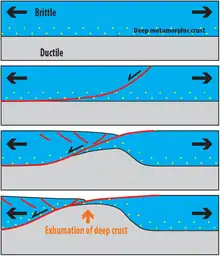
Metamorphic core complexes are exposures of deep crust exhumed in association with largely amagmatic extension. They form, and are exhumed, through relatively fast transport of middle and lower continental crust to the Earth's surface. During this process, high-grade metamorphic rocks (eclogite-, granulite- to amphibolite- facies) are exposed below low-angle detachment faults (and mylonitic shear zones) that show ductile deformation on the lower side (footwall) with amphibolite- to greenschist-facies syndeformational metamorphism, and ductile-brittle to brittle deformation on the upper-side (hanging-wall) with tilted geometries.
Descriptions
- Coney 1980 stated that they:
are characterized by a generally heterogeneous, older metamorphic-plutonic basement terrane overprinted by low-dipping lineated and foliated mylonitic and gneissic fabrics. An unmetamorphosed cover terrane is typically attenuated and sliced by numerous subhorizontal younger-on-older faults. Between the basement and cover terranes is a decollement and/or steep metamorphic gradient with much brecciation and kinematic structural relationships indicating sliding or detachment.
The decollement is also called a detachment fault.
Metamorphic core complexes form as the result of major continental extension, when the middle and lower continental crust is dragged out from beneath the fracturing, extending upper crust. Movement zones capable of producing such effects evolve in space as well as with time. Deforming rocks in the footwall are uplifted through a progression of different metamorphic and deformational environments, producing a characteristic sequence of (overprinted) meso- and microstructures.
Location
The core complex model was first developed in the cordillera of western North America, with older cores found in the north (Eocene), and younger to the south. Globally, core complexes are thought to be found in the Aegean Sea (Philippon 2014), Anatolia, Iran, Tibet, north China, Slovakia (Janak et al. 2001), Venezuela-Trinidad (Miocene), New Zealand and West Antarctica (McFadden et al. 2010). The youngest core complex is found in eastern New Guinea.
Core complexes on other planets
A feature at the center of Artemis Corona on Venus has been suggested as a metamorphic core complex (Spencer 2001). This could be the largest metamorphic core complex in the solar system.
See also
References
- Coney, P.J. (1980). Crittenden, M.D.; Coney, P.J.; Davis, G.H. (eds.). "Cordilleran Metamorphic Core Complexes". GSA Memoir. Geological Society of America. 153: 7–34. doi:10.1130/MEM153-p7.
- Janák, M.; Plašienka, D.; Frey, M.; Cosca, M.; Schmidt, S. TH.; Lupták, B.; Méres, Š. (February 2001). "Cretaceous evolution of a metamorphic core complex, the Veporic unit, Western Carpathians (Slovakia): P–T conditions and in situ40Ar/39Ar UV laser probe dating of metapelites". Journal of Metamorphic Geology. 19 (2): 197–216. doi:10.1046/j.0263-4929.2000.00304.x. S2CID 129901824.
- Lister, G.S.; Davis, G.A. (1989). "The origin of metamorphic core complexes and detachment faults formed during Tertiary continental extension in the northern Colorado River region, U.S.A." (PDF). J. Struct. Geol. 11 (1–2): 65–94. doi:10.1016/0191-8141(89)90036-9.
- McFadden, R.; Teyssier, C.; Siddoway, C. S.; Whitney, D.; Fanning, C. M. (2010). "Oblique dilation, melt transfer, and gneiss dome emplacement". Geology. 38 (4): 375–378. doi:10.1130/G30493.1.
- Philippon, M. (2014). Philippon, M.; Brun, J.-P.; Gueydan, F.; Sokoutis, D. (eds.). "The interaction between Aegean back-arc extension and Anatolia escape since Middle Miocene". Tectonophysics. 631: 176–188. doi:10.1016/j.tecto.2014.04.039. S2CID 53683418.
- Spencer, J. E. (2001). "Possible giant metamorphic core complex at the center of Artemis Corona, Venus". Geological Society of America Bulletin. 113 (3): 333–345. doi:10.1130/0016-7606(2001)113<0333:PGMCCA>2.0.CO;2. ISSN 0016-7606.
External links
- Metamorphic core complexes
- Cordilleran metamorphic core complexes: Cenozoic extensional relics of Mesozoic compression Peter J. Coney. Tekla A. Harms. Geology, September, 1984